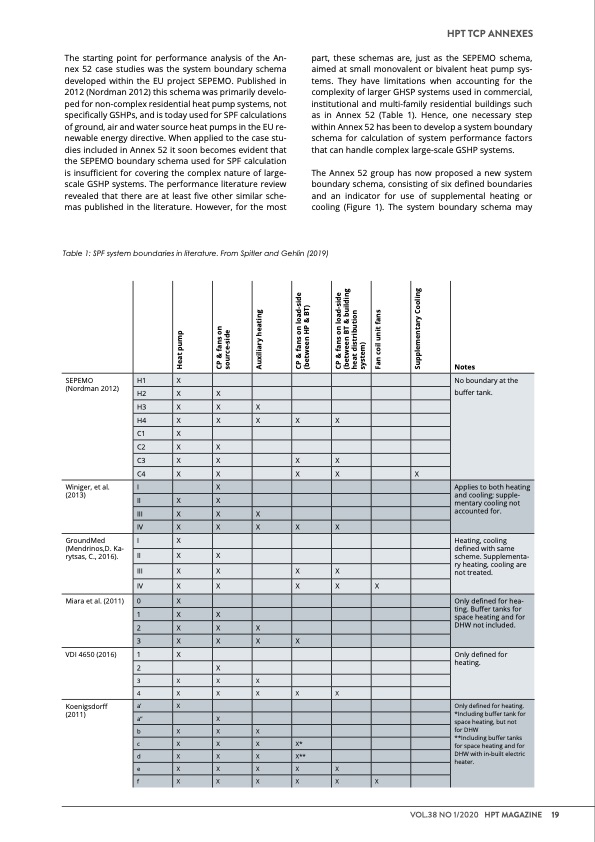
PDF Publication Title:
Text from PDF Page: 019
The starting point for performance analysis of the An- nex 52 case studies was the system boundary schema developed within the EU project SEPEMO. Published in 2012 (Nordman 2012) this schema was primarily develo- ped for non-complex residential heat pump systems, not specifically GSHPs, and is today used for SPF calculations of ground, air and water source heat pumps in the EU re- newable energy directive. When applied to the case stu- dies included in Annex 52 it soon becomes evident that the SEPEMO boundary schema used for SPF calculation is insufficient for covering the complex nature of large- scale GSHP systems. The performance literature review revealed that there are at least five other similar sche- mas published in the literature. However, for the most ANNEX Table 1: SPF system boundaries in literature. From Spitler and Gehlin (2019) HPT TCP ANNEXES part, these schemas are, just as the SEPEMO schema, aimed at small monovalent or bivalent heat pump sys- tems. They have limitations when accounting for the complexity of larger GHSP systems used in commercial, institutional and multi-family residential buildings such as in Annex 52 (Table 1). Hence, one necessary step within Annex 52 has been to develop a system boundary schema for calculation of system performance factors that can handle complex large-scale GSHP systems. The Annex 52 group has now proposed a new system boundary schema, consisting of six defined boundaries and an indicator for use of supplemental heating or cooling (Figure 1). The system boundary schema may SEPEMO (Nordman 2012) H1 X H2 X X No boundary at the buffer tank. H3 X X X H4 X X X X X C1 X C2 X X C3XX XX C4 X X X X X Winiger, et al. (2013) IX Applies to both heating and cooling; supple- mentary cooling not accounted for. GroundMed (Mendrinos,D. Ka- rytsas, C., 2016). II X X III X X X IV X X X X X IX Heating, cooling defined with same scheme. Supplementa- ry heating, cooling are not treated. II X X III X X X X IV X X X X X Miara et al. (2011) 0X Only defined for hea- ting. Buffer tanks for space heating and for DHW not included. 1XX 2XXX 3XXXX VDI 4650 (2016) 1X Only defined for heating. 2X 3XXX 4XXXXX Koenigsdorff (2011) a’ X Only defined for heating. *Including buffer tank for space heating, but not for DHW **Including buffer tanks for space heating and for DHW with in-built electric heater. a’’ X bXXX c X X X X* d X X X X** eXXXXX fXXXXXX Notes VOL.38 NO 1/2020 HPT MAGAZINE 19 Heat pump CP & fans on source-side Auxiliary heating CP & fans on load-side (between HP & BT) CP & fans on load-side (between BT & building heat distribution system) Fan coil unit fans Supplementary CoolingPDF Image | Integration of Heat Pumps into the Future Energy

PDF Search Title:
Integration of Heat Pumps into the Future EnergyOriginal File Name Searched:
HPT-Magazine_no1_2020.pdfDIY PDF Search: Google It | Yahoo | Bing
CO2 Organic Rankine Cycle Experimenter Platform The supercritical CO2 phase change system is both a heat pump and organic rankine cycle which can be used for those purposes and as a supercritical extractor for advanced subcritical and supercritical extraction technology. Uses include producing nanoparticles, precious metal CO2 extraction, lithium battery recycling, and other applications... More Info
Heat Pumps CO2 ORC Heat Pump System Platform More Info
| CONTACT TEL: 608-238-6001 Email: greg@infinityturbine.com | RSS | AMP |